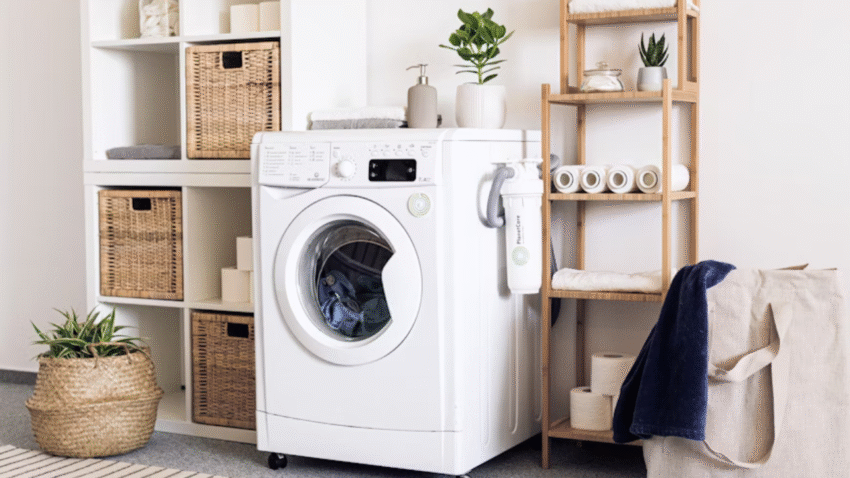Introduction
Laundry rooms often get overlooked when it comes to home design, but fresh, well-painted cabinets can transform the entire space. Learning how to paint laundry room cabinets for a fresh look is a budget-friendly way to add style, brighten the room, and make the space feel more inviting. Whether your cabinets are outdated wood, laminate, or painted, the right prep and technique can give them a brand-new life.
Why Painting Laundry Room Cabinets Matters
Cabinets take up a large visual area in a laundry room, so updating them has a big impact. Freshly painted cabinets can:
- Brighten the space and make it feel cleaner.
- Add personality with modern, neutral, or bold colors.
- Protect the cabinet material from moisture and wear.
- Increase home value with a low-cost improvement.
Since laundry rooms can be humid, it’s important to use the right products and methods to ensure a durable finish.
Step-by-Step Guide to Painting Laundry Room Cabinets for a Fresh Look
1. Choose the Right Paint and Finish
What to do:
- Use a high-quality cabinet paint or enamel for durability.
- Semi-gloss or satin finishes are ideal—they’re easy to wipe clean.
- If your laundry room is humid, choose a moisture-resistant paint.
Why it works:
The right paint resists chipping, peeling, and moisture damage, ensuring the finish lasts.
2. Select a Color That Fits the Space
What to do:
- Light colors (white, cream, pale gray) make small laundry rooms feel larger.
- Bold colors (navy, deep green) add a modern, stylish touch.
- Consider the color of walls, flooring, and appliances for a cohesive look.
Why it works:
Color choice affects mood, perceived space, and how well the room blends with the rest of the home.
3. Gather Supplies
You’ll need:
- Screwdriver or drill
- Painter’s tape
- Drop cloths or plastic sheeting
- Degreaser or mild cleaner
- Sandpaper (120- and 220-grit) or sanding block
- Primer (stain-blocking if painting over dark wood)
- Paintbrushes and small foam rollers
- High-quality cabinet paint
- Tack cloth or microfiber rag
Why it works:
Having all materials ready makes the process smoother and prevents delays.
4. Remove Cabinet Doors and Hardware
What to do:
- Unscrew hinges and handles/knobs.
- Label doors and hinges with painter’s tape so they go back in the correct spots.
- Store hardware in labeled bags to keep pieces organized.
Why it works:
Removing doors and hardware allows for even coverage and a cleaner finish.
5. Clean the Cabinets Thoroughly
What to do:
- Wipe all surfaces with a degreaser or a mix of warm water and dish soap.
- Rinse with a damp cloth and let dry completely.
Why it works:
Paint won’t adhere properly to dirt, grease, or detergent residue.
6. Sand for a Smooth Surface
What to do:
- Lightly sand all cabinet surfaces with 120-grit sandpaper to remove gloss.
- Wipe away dust with a tack cloth.
- For laminate cabinets, sand lightly just enough to rough up the surface.
Why it works:
Sanding creates a surface that primer and paint can grip.
7. Apply Primer
What to do:
- Use a stain-blocking primer for dark wood or previously painted surfaces.
- Apply a thin, even coat with a brush or foam roller.
- Let it dry completely before painting.
Why it works:
Primer seals the surface, blocks stains, and ensures better paint adhesion.
8. Paint the Cabinets
What to do:
- Apply the first coat of paint using a foam roller for flat surfaces and a brush for corners and edges.
- Let it dry according to the paint manufacturer’s instructions.
- Lightly sand with 220-grit sandpaper between coats for a professional finish.
- Apply a second (and possibly third) coat for full coverage.
Why it works:
Multiple thin coats create a smooth, durable finish without drips or brush marks.
9. Let the Paint Cure
What to do:
- Allow the paint to cure for at least 24–48 hours before reattaching hardware.
- Avoid heavy use until the paint is fully hardened (about 7 days).
Why it works:
Curing time prevents chips, smudges, and fingerprints on the fresh paint.
10. Reattach Hardware and Doors
What to do:
- Reinstall hinges and handles.
- Make sure doors are aligned and close smoothly.
Why it works:
Proper reinstallation ensures the cabinets function well and look professionally finished.
Common Mistakes to Avoid
Mistake 1: Skipping Sanding
Solution: Always sand for better paint adhesion.
Mistake 2: Using Wall Paint Instead of Cabinet Paint
Solution: Choose a durable enamel or cabinet-specific formula.
Mistake 3: Painting in a Humid or Dusty Room
Solution: Work in a clean, dry space to avoid imperfections.
Mistake 4: Applying Thick Coats
Solution: Use multiple thin coats to prevent drips and uneven texture.
Mistake 5: Reattaching Doors Too Soon
Solution: Allow proper curing time for maximum durability.
Extra Laundry Tips & Hacks
- Update cabinet hardware for an instant style upgrade after painting.
- Use self-adhesive shelf liner inside cabinets for easy cleaning.
- Install under-cabinet lighting to brighten your laundry workspace.
- Related guide: Check out our article on “How to Keep a Laundry Room Clutter-Free All Year” for organizing tips after your makeover.
Conclusion
Painting laundry room cabinets is an easy, cost-effective way to refresh your space without a full remodel. By choosing the right paint, preparing surfaces properly, and taking your time with each step, you can achieve a durable, professional-looking finish that makes your laundry room brighter and more inviting.
Bonus Tip: Keep leftover paint in a sealed container for quick touch-ups if cabinets get scuffed over time.
Bookmark this guide so you can give your laundry room a fresh, updated look whenever you’re ready for a change.
